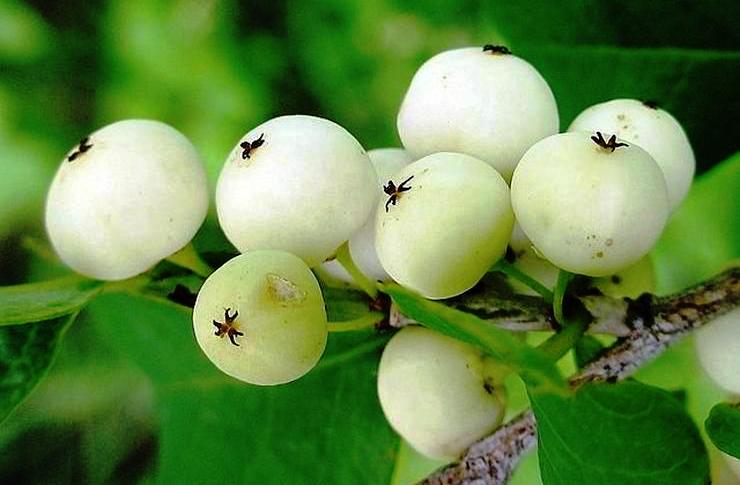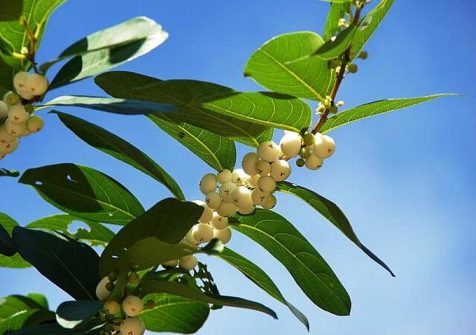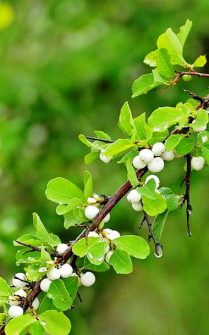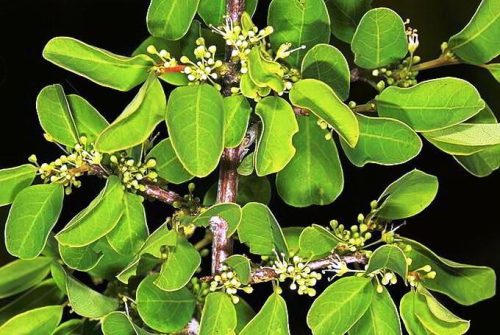Herbs & Plants. Flueggea virosa. A wide range of healing virtues.

The plant is a cornerstone in traditional medicine across tropical Africa, revered for its myriad therapeutic properties. It is well integrated into the fabric of human life, healing, preserving cultural heritage and maintaining ecological harmony.
Flueggea virosa, known for its dioecious nature, presents itself as a multi-stemmed shrub or occasionally as a spreading tree, reaching heights of 2-3 metres, sometimes up to 4 metres. Its distinctive reddish-brown to brown bark serves as a recognizable feature in its habitat. The foliage of this shrub is adorned with lush green leaves densely packed along the branches. The plant produces delicate, creamy green flowers, a characteristic feature of the species. These flowers, though small, play a crucial role in the plant’s reproductive cycle.

Flueggea virosa is a cornerstone of traditional medicine throughout tropical Africa. CC BY-SA 2.0/Ton Rulkens
Prized by humans and wildlife alike, the fruit has a delicious sweetness with a hint of bitterness, making it particularly popular with children.
Flueggea virosa is a cornerstone of traditional medicine throughout tropical Africa, revered for its myriad therapeutic properties woven into the fabric of indigenous healing practices. Every part of this versatile plant, from its roots to its fruits, is important in treating a wide range of ailments, with the root emerging as the quintessential reservoir of medicinal potency. The roots and fruits are prized for their purported efficacy in treating snakebites.
The roots are also used in many African communities as a contraceptive and as a remedy for a range of ailments including syphilis, gonorrhea, rheumatism and skin conditions such as rashes. An infusion made from the roots is also used as a palliative for malaria.

Flueggea virosa is prized for its therapeutic properties. CC BY-SA 2.0/ Bernard Dupont
The bark of Flueggea virosa is also prized for its therapeutic properties, believed to contain cures for common ailments such as diarrhea and pneumonia. The myriad contributions of Flueggea virosa, from its succulent fruits to its medicinal virtues, underscore its profound importance within ecosystems and human societies alike.
The root, revered as the pinnacle of pharmacological activity within the plant, embodies a wide range of healing virtues, from analgesic and astringent to ophthalmic and sedative properties. In addition, the root serves as a lynchpin in the treatment of a wide range of ailments, including liver, bile, kidney and urinary disorders, as well as providing relief from urinary and genital disorders, diuresis, kidney stones and schistosomiasis.
In addition, its effectiveness extends to alleviating rheumatism, venereal diseases, orchitis, dysmenorrhoea, frigidity and sterility, encapsulating a holistic approach to wellness.
The therapeutic repertoire of the root extends beyond internal medicine to external applications. Root decoctions or powders, whether taken orally or used in baths, show remarkable efficacy in relieving testicular inflammation, headaches, back pain, hernias, wounds, boils, ulcers, skin conditions and even candidiasis. In addition, when combined with fat, the root pulp makes a soothing ointment, underlining its versatility in topical applications.

The leaves and fruits of Flueggea virosa also significantly contribute to the pharmacopoeia of traditional medicine. CC BY-SA 2.0/Forest & Kim Starr
The leaves and fruits of Flueggea virosa also make a significant contribution to the pharmacopoeia of traditional medicine. The leaves, praised for their aphrodisiac and laxative properties, are used to treat fever, venereal diseases and constipation. Leaf macerations used in baths or massages invigorate the body, combat fatigue and relieve stiffness. Leaf decoctions are also an effective antidote to fever and are used for wound healing and in the treatment of epilepsy.
The fruits, though smaller in size, are no less important, offering relief from digestive disorders when eaten. They also hold a special place in women’s health, as it is believed that eating them promotes fertility.
Beyond its medicinal properties, Flueggea virosa permeates many facets of daily life and cultural practices.
The plant’s leaves produce a black dye that is used to dye palm fibres, while the fruits provide a red dye that is used to make ink. The bark is also used for tanning and as fodder for livestock.

Flueggea virosa is remarkably versatile beyond its medicinal uses. CC BY-SA 2.0/ Forest & Kim Starr
The fruits become a popular delicacy, enjoyed for their juicy sweetness with a hint of bitterness. Often eaten by children, these fruits also find their way into alcoholic beverages, enriching cultural traditions with their flavour.Flueggea virosa is remarkably versatile beyond its medicinal uses. Its twigs are used as natural toothbrushes, while its bark, rich in tannins, is used as a dye for matting and palm fibres. However, the black dye from the leaves is considered to be of low quality due to its irregular colouring. Fruit crushing extracts a red dye used in ink production. Wood ash cleans milk containers, while stem gum seals envelopes.
Crushed leaves act as insect repellent. The sturdy virgate trunks are made into a variety of implements, including beds, fishing poles and walking sticks. The reddish-yellow wood, though usually small, is tough and suitable for making chair legs, kitchen utensils and hut poles. It is also valued as a fuel and is used to make charcoal.
In conclusion, Flueggea virosa embodies resilience and adaptability, seamlessly integrating into the fabric of human life by healing, preserving cultural heritage and maintaining ecological harmony. (Photo:CC BY-SA 2.0/Ton Rulkens)
Richard Komakech



